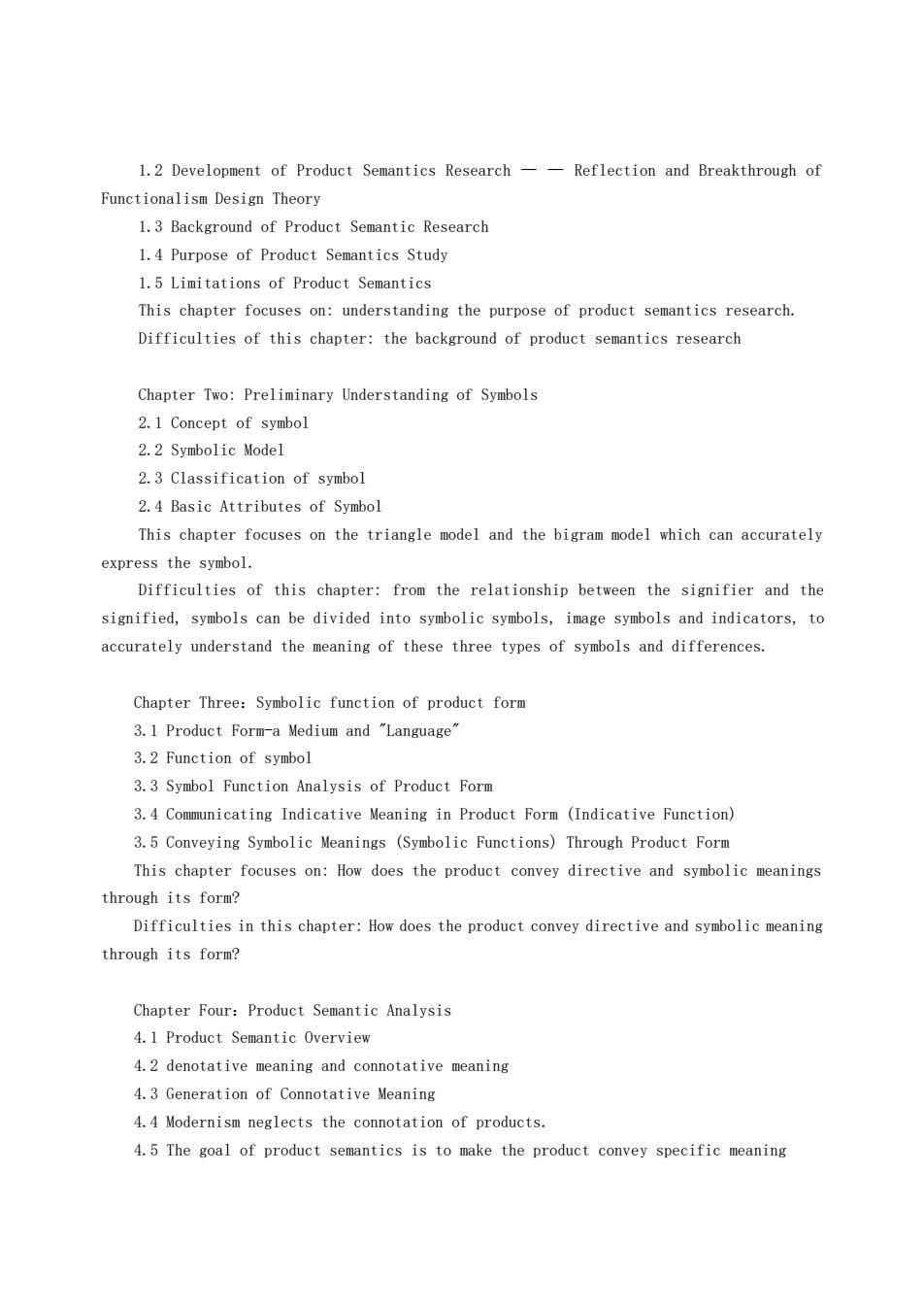正在加载图片...

1.2 Development of Product Semantics Research--Reflection and Breakthrough of Functionalism Design Theory 1.3 Background of Product Semantic Research 1.4 Purpose of Product Semantics Study 1.5 Limitations of Product Semantics This chapter focuses on:understanding the purpose of product semantics research. Difficulties of this chapter:the background of product semantics research Chapter Two:Preliminary Understanding of Symbols 2.1 Concept of symbol 2.2 Symbolic Model 2.3 Classification of symbol 2.4 Basic Attributes of Symbo This chapter focuses on the triangle model and the bigram model which can accurately express the symbol. Difficulties of this chapter:from the relationship between the signifier and the signified,symbols can be divided into symbolic symbols,image symbols and indicators,to accurately understand the meaning of these three types of symbols and differences. Chapter Three:Symbolic function of product form 3.1 Product Form-a Medium and "Language 3.2 Function of symbol 3.3 Symbol Function Analysis of Product Form 3.4 Communicating Indicative Meaning in Product Form (Indicative Function) 3.5 Conveying Symbolic Meanings (Symbolic Functions)Through Product Form This chapter focuses on:How does the product convey directive and symbolic meanings through its form? Difficulties in this chapter:How does the product convey directive and symbolic meaning through its form? Chapter Four:Product Semantic Analysis 4.1 Product Semantic Overview 4.2 denotative meaning and connotative meaning 4.3 Generation of Connotative Meaning 4.4 Modernism neglects the connotation of products. 4.5 The goal of product semantics is to make the product convey specific meaning1.2 Development of Product Semantics Research — — Reflection and Breakthrough of Functionalism Design Theory 1.3 Background of Product Semantic Research 1.4 Purpose of Product Semantics Study 1.5 Limitations of Product Semantics This chapter focuses on: understanding the purpose of product semantics research. Difficulties of this chapter: the background of product semantics research Chapter Two: Preliminary Understanding of Symbols 2.1 Concept of symbol 2.2 Symbolic Model 2.3 Classification of symbol 2.4 Basic Attributes of Symbol This chapter focuses on the triangle model and the bigram model which can accurately express the symbol. Difficulties of this chapter: from the relationship between the signifier and the signified, symbols can be divided into symbolic symbols, image symbols and indicators, to accurately understand the meaning of these three types of symbols and differences. Chapter Three:Symbolic function of product form 3.1 Product Form-a Medium and "Language" 3.2 Function of symbol 3.3 Symbol Function Analysis of Product Form 3.4 Communicating Indicative Meaning in Product Form (Indicative Function) 3.5 Conveying Symbolic Meanings (Symbolic Functions) Through Product Form This chapter focuses on: How does the product convey directive and symbolic meanings through its form? Difficulties in this chapter: How does the product convey directive and symbolic meaning through its form? Chapter Four:Product Semantic Analysis 4.1 Product Semantic Overview 4.2 denotative meaning and connotative meaning 4.3 Generation of Connotative Meaning 4.4 Modernism neglects the connotation of products. 4.5 The goal of product semantics is to make the product convey specific meaning